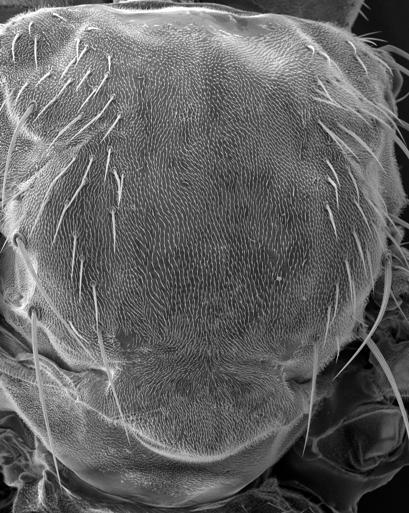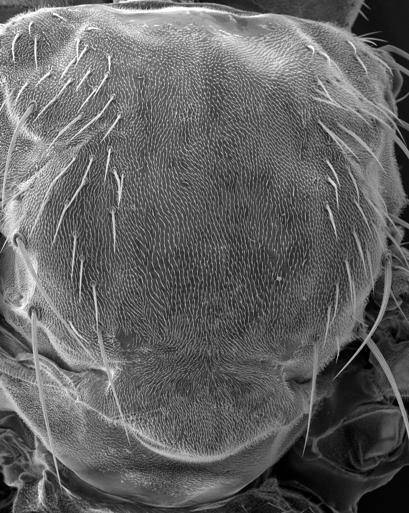
Credit: © UNIGE / Marcos Gonzalez-Gaitan
Things couldn't be simpler at the start: the cells divide into two identical cells that then divide in turn, meaning that any tissue can grow at an exponential rate. But the moment comes when some of them have to develop into specialised cells. On the back of a fly, for example, a cell must "know" that when it splits, it will give birth to two fundamentally different cells: one will make a hair and the other one, a neuron. How do these asymmetric divisions function? How can a mother cell split into two daughter cells that are so different? The researchers at UNIGE set about trying to understand these mechanisms down to the last detail, as the stakes are extremely high: a stem cell that misses out on its asymmetric division may generate cancer cells that reproduce exponentially, forming a tumour. You can read about the results of this research in Nature Communications, where the scientists demonstrate how the required information circulates inside the mother cell, enabling it to make a success of the asymmetric division.
In asymmetrical cell division, the two future cells "talk" to each other and divide their roles: "You'll become that, and I'll become this." They exchange information via proteins which carry the message. , These proteins are themselves contained in tiny vesicles, called endosomes. These endosomes act as a kind of cellular memory card: they are responsible for instigating the specialisation by migrating to one of the two daughter cells, where the information will be processed and subsequently transmitted to the sister cell. The key to this specialisation, therefore, lies in the ability of the endosomes to move to the left or right of the mother cell so that they are only present in one of the two daughters. But how do they go about this?
To analyse the phenomenon, the team led by Professor Marcos Gonzalez-Gaitan (from the biochemistry department in UNIGE's faculty of sciences) examined the hairs on the backs of flies, more precisely on fruit flies (Drosophila). These hairs are, in fact, sensory organs consisting of four cells, which are capable of picking up the force and direction of the wind: this is important to fly. Each hair — or sensory organ — originates from a single cell or SOP (sensory organ precursor), which first divides asymmetrically, producing two different cells, PIIA and PIIB. Each of these cells divides asymmetrically in turn, generating the four final cells. This is the ideal setting for attempting to understand how — and why — the endosomes move and make these asymmetric divisions possible.
Without Sara, nothing goes!
The first clue lies in the fact that the Sara protein is present in the endosomes, which helps them group together on the same side of the cell. When genetically-modified, mutant flies are deprived of the Sara gene — and, by extension, of the protein that it produces — the SOPs divide symmetrically and the hairs do not form; the flies, in other words, have naked backs without hairs. In the first phase of the research, Professor Gonzalez-Gaitan's team was able to show that the same process occurs in other types of cells, such as intestinal stem cells and even in the vertebrate nervous system, thanks to observations on fish.
Sara provides the crucial piece of information, therefore, that decides which daughter cell will receive the endosomes. However, this does not explain why they assemble in only one of the two daughter cells. More detailed observation was required to understand this mechanism. Microtubules inside the mother cell serve as tracks for transporting the endosomes, driven by a molecular motor called kinesin. The tracks are polarised (they are one-way-roads) and the kinesin always moves in the same direction. Some of the tracks lead to the left, others to the right, and the kinesin passes from one to the other, oscillating in the centre of the cell in a rapid sequence. Because there are more tracks pointing to one cell, at the end the endosomes, with the key message in them, are sent towards the right cell. But at the end, the endosomes need to scape from the trap to be delivered to the PIIA cell, which will make the hair. How?
On the right track
To escape from this trap and to allow the endosomes to gather on the proper side, it is essential not only that the Sara protein is present, but also that it is bound to a molecular extension known as a phosphate group. Professor Gonzalez-Gaitan and his team succeeded in demonstrating the key role played by this phenomenon. Known as phosphorylation, it acts like a central switch signalling the start of the final migration of the endosomes to be released to the right cell. Without this process, the information could not circulate between cells, which would then prevent any differentiation between the two daughter cells… condemning the flies to everlasting baldness! Anomalies in the way these fascinating molecular phenomena function in the cells lies behind the emergence of certain cancer tumours in humans.
###
Media Contact
Marcos Gonzalez-Gaitan
[email protected]
41-223-796-461
@UNIGEnews
http://www.unige.ch
############
Story Source: Materials provided by Scienmag





